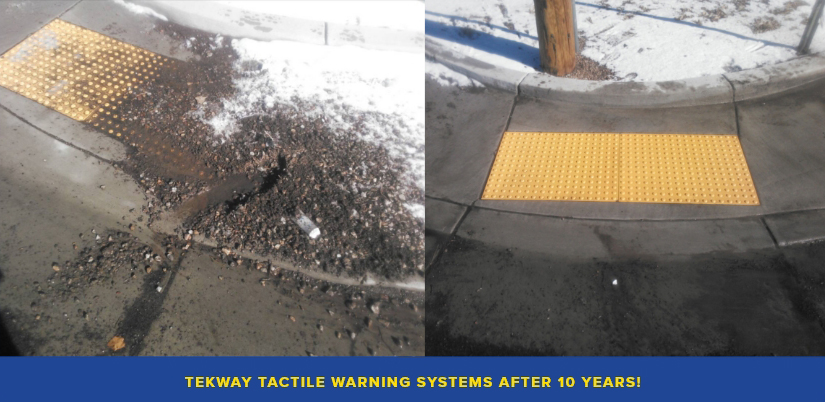ADA Compliance for Detectable Warnings
ADA Detectable warnings are designed to help millions of Americans with low or no vision safely navigate roads and transit areas, and are required by law to meet specific standards.
In 1991 the USDOT and USDOJ developed legal regulations from the Americans with Disabilities Act. In these guidelines, the requirements for the installation of detectable warnings were specified for sidewalks, street crossings and curb ramps, hazardous vehicular ways, and transit platform edges for the safety of visually impaired citizens.
TekWay High-Performance ADA Systems uphold the fullest compliance, including ADA standards of sizes and colors. Aesthetically pleasing domes are available in almost all natural and federal colors, sizes, dome spacing, and shapes.

How does TekWay® meet the requirements of detectable warnings?
Dome Shape & Dimensions
Dome Spacing
Slip Resistance
Low Water Absorption
Color Contrast with Surrounding Area
Maintain Functionality and Compliance
Durability in High and Low Traffic areas
Ease and Reliability of Installation
Installing detectable warnings in the required locations
ADAAG 4.29.5 Detectable Warnings at Hazardous Vehicular Areas:
"... at Walking Surfaces which are not separated by curbs, railings, or other areas between the pedestrian areas and vehicular areas, the boundary between the areas shall be defined by a continuous detectable warning..."

Using a product that meets the requirements of the law
Dome Shape—ADAAG 1108.1.1:
"Truncated Domes shall have a base diameter of 0.9 inches minimum to 1.4 inches maximum, a top diameter of 50% of the base diameter minimum to 65% base diameter maximum, and a height of 0.2 inches".
Dome Spacing—ADAAG 1108.1.2:
"Truncated domes shall have a center-to-center spacing of 1.6 inches minimum and 2.4 inches maximum ....".
Contrast—ADAAG 1108.1.3:
"Detectable warning surfaces shall contrast visually with adjacent walking surfaces, either Light-on-Dark or Dark-on-Light".

Maintaining the product so the site remains compliant
Title III, 36.211—Maintenance of accessible features:
“A public accommodation shall maintain in operable working conditions all features that are required to be readily accessible to and usable by persons with disabilities ….”




